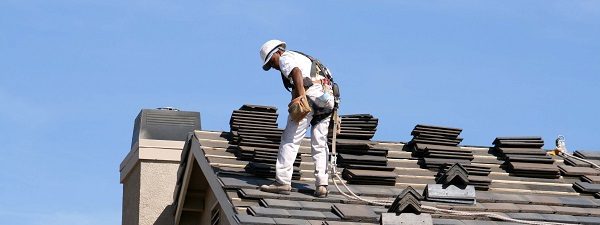
Published on September 3, 2019
During home improvements or even a remodel, many homeowners decide to give their home a new look with a different kind of roofing material. Many decide to stick with what’s already on the home, with perhaps a different shade or color.
But with so many styles on the market – all with their own appeal – some homeowners are thinking about going with a completely different look. Roofing also has varying degrees of durability (and price), but nothing will protect the home against acts of nature, such as a tree blowing over in a winter storm.
And always remember this: the lifespan of the roofing is dependant on being properly installed. Roofs installed poorly will fail no matter the price tag. Let’s take a look at different kinds of roofing options:
- Metal Roofing
- Slate Roofing
- Architectural Shingles
- Shake or Wood Roofing
Metal Roofing
There’s nothing like raindrops crashing down on a metal roof, the cacophony of sound making a tempest out of a drizzle. For the most part, however, metal roofing has been relegated to sheds, barns, and other outbuildings. As home designs and styles change, metal roofing is beginning to appear in more modern residential housing.
At first, metal roofing was restricted to those at the higher-end of the income spectrum, at least in urban and closer in suburban areas. However, as the look gain widespread appeal, prices are falling and becoming more accessible. Unfortunately, not every roofing company will install this type of roofing, even though newer products are making the job simpler.
Standing seam metal roofing actually reduces the number of seams needed for installation. Sections are created from rolls of metal and run through a crimping machine to make the ridges. The seams come in a few varieties, including snap-lock, mechanical seam, and batten panel.
No matter the variety, these panels are made to go from the peak to the bottom edge of the roof in one piece. This means no horizontal seams at all in most cases. The panels then fit together and create a raised seam, sometimes an inch above the surface of the roof and away from the cascading rain.
Properly installed, these roofs can last up to 50 years. You’ll pay for it upfront, but when you consider the lifespan, it evens out over time.
Slate Roofing
For peak curb appeal, slate tiles are tough to beat. An innate beauty, interesting texture, and a variety of colors, slate roofs are favored by designers and homeowners looking to show off a little. They are at the top of the price range (the showing off part perhaps?), but can also last up to 100 years or more.
Slate is also very resistant to fire. Not that it will keep the rest of your home safe, but this material can limit the flames from punching through the roof. There are some drawbacks though: the price can be eye-popping and slate can be fragile if mishandled. It’s also much heavier than other roofing materials.
To combat those issues, there are composite slate tiles on the market. Made to look like slate, the tiles are lighter and also very fire resistant. They won’t last as long, however, topping out at the 50-year range.
Architectural Shingles
Also referred to as laminated or dimensional, architectural shingles are made to mimic the look of slate or shake roofing, but at a lower price. Easier to install, too. Of course, they won’t last as long slate tiles with an average lifespan of around 30-50 years.
Sturdier than 3-tab, these shingles will stand up to strong winds (up to 120 miles per hour in some cases) and require less maintenance than their higher cost cousins. It’s an ideal choice for homeowners looking to give their home a touch of class without having to pay for it.
Cedar Shake
This wood roofing definitely appeals to the senses. When looking at this distinct roofing, you can almost smell the fresh ocean air. Unlike other materials, when cedar shakes or shingles fade over time, they still retain that timeless look. That beauty belies its strength: cedar shakes can last up to 40 years in all kinds of conditions.
Cedar shakes have a rough appearance while cedar shingles are smoother, much like how the slats in the backyard fence look. They also come in a variety of colors, thanks to oils, stains, and even paints. This customization will give a home a very distinct look.
To cut down on maintenance, these shakes can be infused with additives to prevent moss, mildew, and fungi. But they still need to be regularly maintained, cost more, and are more difficult to install than 3-tab shingles. But it’s tough to beat the traditional beauty.
These are just a few of the roofing options available to homeowners and builders in the Pacific Northwest and around the United State. Spanish clay and concrete tiles, “green” roofing that uses moss and such as an advantage, and even flat roofing that uses a rubberized coating to keep the house dry and just a few of those choices.
When it comes to the best roofing for a home, there can’t be just one answer. If a homeowner is looking for durability, slate tiles are tough to beat and look great. If finances are a concern, the old reliable asphalt shingles may be the way to go.
Your home is a big investment, so it’s important to take all of those factors into consideration. If you are thinking about having a new roof installed, or unsure about what kind of roof you want on your new build, reach out to Warner Roofing and Construction.
We work many kinds of roofing materials in the greater Vancouver area as well as installing and repairing roofs for nearly 30 years. We also help design roofing systems, including gutters, skylights, and solar tubes. If you have any roofing questions, we’ll be happy to answer them.